Organo-biological top dressing TOP
TOP – fundamentally new type of fertilizer. An organomineral complex that is formed as a result of the processing of agricultural, poultry and livestock waste (cattle manure, pig manure, bird droppings, etc.) in a biogas reactor.
| Brand | SibBioGas |
| Purpose | Base |
| View | Liquid |
| Growing method | The soil, Substrates |
| Phase | vegetation, root formation, Bloom |
| Application | Root top dressing, spraying |
| Producing country | Russia |
The use of "TOR" in crop production, it allows to reduce the consumption of natural fertilizers per hectare of cultivated soil and significantly increase the seasonal yield. The effectiveness of the fertilizer is achieved due to its unique composition "TOP":
- Balanced complex of macro- and micronutrients. As in the usual fertilizers, the complex nourishes the soil and plants, increasing the strength of growth and productivity. At the same time, products that grow on this fertilizer do not contain nitrates, nitrites, but, on the contrary, are enriched with useful salts, metals, semi-metals, etc.
- Phytohormones. Regulate the growth and development of plants, maintain the integrity of the plant organism, coordinate the interaction of cells, tissues, organs. They affect the ability of plants to adapt to the action of adverse environmental factors (lack of moisture, extreme temperatures, soil salinization, lack of oxygen, UV radiation, the action of pathogens, viruses, etc.) Phytohormones can be used to wet seeds, accelerate germination, as basic fertilizer and foliar top dressing.
- Nitrogen-fixing lysospheric bacteria. Once in the soil, they begin to multiply and process the organic matter entering the soil. They fix useful nitrogen from the air, saturating the soil with it. They supply the plant with physiologically active substances, vitamins, available nitrogen.
- Fulvic and humic acids (humates) are found in large quantities: they restore soil fertility, heal damaged plant tissues and organs, prevent the development of many diseases, purify the environment, destroy infections, viruses, neutralize radiation and toxins. Useful for people.
- Negative redox potential of the composition does not burn the soil.
- Neutral pH factor does not lead to salinization or alkalization of the soil, restores its normal acid-base balance.
State tests of the means «TOR» confirmed the useful composition of the product, as well as 100% absence of pathogenic microflora in it: live plant seeds, helminths, parasites, fly eggs, etc.
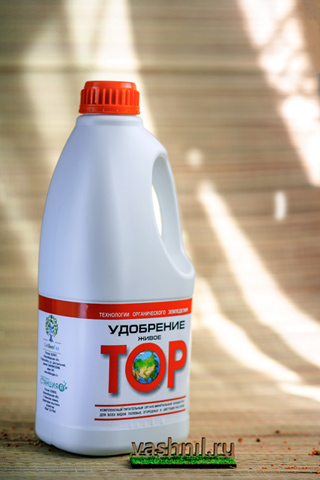
Organic Fertilizer «TOR» has Certificate of compliance with GOST requirements.
The result of using "TOR"
In Russia, the effectiveness of the drug was confirmed by production tests conducted on the basis of agricultural enterprises. The experiments involved different agricultural crops, both greenhouse and grown in the fields.
In plants treated with "TOR" observed:
- Stimulation of seed germination, acceleration of embryo growth.
- More powerful (by 10-20%) root system, with many root hairs, which increases the amount of nutrients entering the above-ground plant organs.
- Strengthening the growth of the vegetative mass, the formation of additional shoots, the rapid pouring of fruits. Slowing down the aging of plants (rejuvenating effect).
- Earlier fruit ripening - 2 weeks earlier than usual;
- Increase in yield on average 30-250%.
Composition
| Water | ppm % | 94-96 |
| pH, pH | unit pH | 7,2 |
| Macro elements | ||
| Nitrogen total | ppm % | 0.36 |
| Phosphorus (P2O5) | ppm % | 0.3 |
| Potassium (K2O) | ppm % | 0.44 |
| Trace elements | ||
| Copper (gross grade) | mg/kg | 25 |
| Copper (moving form) | mg/kg | 0.61 |
| Zinc (gross content) | mg/kg | 53 |
| Zinc (mobile form) | mg/kg | 2.55 |
| Cadmium (gross content) | mg/kg | 0.06 |
| Humic acids (humates) and fulvic acids | ||
| Humic acids | mg/l, not less than | 1000 |
| Fulvic acids | mg/l, not less than | 1000 |
| Phytohormones (growth regulators) | ||
| Auxins (by indolyl-3-acetic acid) | mg/l, not less than | 3 |
| Gibberelins (by gibberellic acid) | mg/l, not less than | 17 |
| Cytokinins (by kinetin) | mg/l, not less than | 500 |
| Macrobiological indicators | ||
| Soil nitrogen-fixing and rhizospheric bacteria | MSH/l | 1x1015 |
| Sanitary and epidemiological indicators | ||
| Helminth larvae | ind./kg | missing |
| Helminth eggs | ind./kg | missing |
Prepare the solution according to the table.
Water the plants with the resulting solution once a week at the rate of:
- 20 ml/m2 in May
- 25 ml/m2 in June
- 30 ml/m2 in July
- 20 ml/m2 in August
- 10 ml/m2 in September
Apply the solution in the evening or on a cloudy day.
When foliar feeding, keep out of direct sunlight.
Table of mortar preparation
| Culture | Main Injection | Soil feeding | Foliar application | |||
|---|---|---|---|---|---|---|
| proportion | terms | proportion | terms | proportion | terms | |
| Potato | 1:15 | May | 1:50 | June | 1:50 | July |
| Beets | 1:18 | April | 1:42 | May | 1:42 | July |
| Tomatoes | 1:13 | March | 1:40 | June | 1:38 | July |
| Cabbage | 1:8 | March | --- | --- | 1:24 | May |
| Bow | 1:10 | March | 1:23 | April | 1:25 | May |
| Carrot | 1:8 | April | 1:20 | April | 1:23 | May |
| Pepper | 1:8 | April | 1:20 | May | 1:24 | June |
| Cucumber | 1:8 | May | 1:15 | May | 1:15 | June |
| Flower plants | 1:20 | April | 1:20 | May | --- | --- |
| Greenhouse Crops | 1:20 | March | 1:17 | April | 1:16 | May-June |
| Garden Trees | 1:20 | April | 1:33 | May | --- | --- |
| Perennials | 1:13 | November | --- | 1:20 | May-June | |
What does the introduction of biofertilizers into the soil give?
Results of state field tests of fertilizers obtained:
Wheat
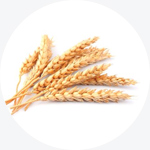
field in Central Russia
Corn

field in Central Russia
Cucumber
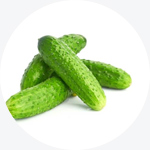
Nizhny Novgorod agrochemical center
Buckwheat

field in Central Russia
Tomato, pepper, eggplant
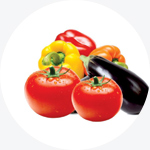
JSC «Dzerzhinskoe» (greenhouse plant)
Potato
Variety "Bryansk Early"
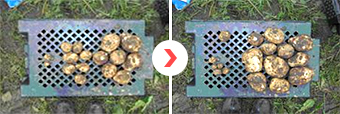
Variety "Lugovskoy"
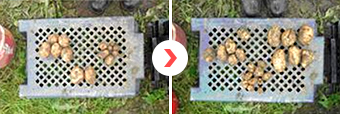
Variety "Aksamit"
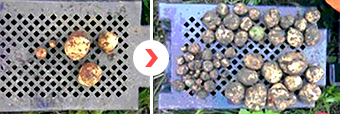
For varieties "Cardinal", "Bryansk early", "Aksamit", "Snow White" there is an increase in the number and size of potato tubers of all fractions. For varieties "Sante", "Lugovskoy", "Scrub" there is an increase in the share of large (commercial) fraction in the total number of tubers.